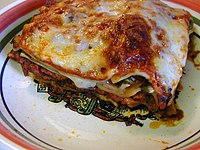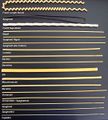Pasta
| Foods |
|---|
|
Bread - Pasta - Cheese - Rice |
| Preparation techniques and cooking items |
| Techniques - Utensils Weights and measures |
| See also: |
| Kitchens - Meals Wikibooks: Cookbook |
Pasta (Italian for "dough") is a generic term for Italian variants of noodles, food made from a dough of flour, water and/or eggs, that is boiled. The word can also denote dishes in which pasta products are the primary ingredient, served with sauce or seasonings.
There are approximately 350 different shapes of pasta. Examples include spaghetti (solid, thin cylinders), maccheroni (tubes or hollow cylinders), fusilli (swirls), and lasagne (sheets). Two other noodles, gnocchi and spätzle, are sometimes counted as pasta. The former are traditional in Italy. Pasta is categorized in two basic styles: Dried and Fresh. Depending upon whether or not pasta includes eggs as an ingredient, the shelf life of pasta can be several years. Pasta is boiled before consumption.
Italian pasta, from Latin pasta "dough, pastry cake, paste", from Greek πάστα (pasta) "barley porridge".
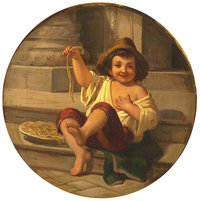
Ingredients
Pasta ingredients span a wide range. Most pastas are made from a combination of simple flour and water mixtures. Pre-packaged speciality pasta often includes spices and cheeses, while others include added coloring from spinach, tomatoes, and food dye.
Under Italian law, dry pasta (pasta secca) can only be made from durum wheat or semolina flour. Durum flour has a yellow tinge in color. Italian pasta is traditionally cooked al dente (Italian: "to the tooth", meaning not too soft). Abroad, dry pasta is frequently made from other types of flour (such as farina), but this yields a softer product, which cannot be cooked al dente.
Particular varieties of pasta may also use other grains and milling methods to make the flour. Some pasta varieties, such as Pizzoccheri, are made from buckwheat flour. Various types of fresh pasta include eggs (pasta all'uovo). Gnocchi are often listed among pasta dishes, although they are quite different in ingredients (mainly milled potatoes) and therefore can't be called pasta.
History
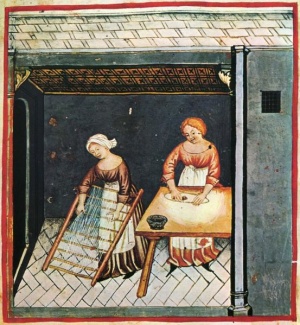
Though the Chinese were eating noodles as long ago as 1500 BC (known thanks to the discovery of a well-preserved bowl of noodles over 4000 years old), the familiar legend of Marco Polo importing pasta from China is just that—a legend, whose origins lie not in Polo's Travels, but was introduced by Arabs during their conquest of Sicily (newsletter of the National Macaroni Manufacturers Association).
The works of the 2nd century AD Greek physician Galen mention itrion, homogeneous compounds made up of flour and water. The Jerusalem Talmud records that itrium, a kind of boiled dough, was common in Palestine from the 3rd to 5th centuries AD. But these references are vague and simply speculate on a possible connection to modern pasta.
A dictionary compiled by the 9th century Syrian physician and lexicographer Isho bar Ali defines itriyya as string-like shapes made of semolina and dried before cooking, probable evidence of Arab influence on the ancestor to modern-day dried pasta. One form of itrion with a long history is laganum (plural lagana), which in Latin refers to a thin sheet of dough. In the 1st century BC work of Horace, lagana were fine sheets of dough which were fried and were an everyday food. Writing in the 2nd century Athenaeus of Naucratis provides a recipe for lagana which he attributes to the 1st century Chrysippus of Tyana: sheets of dough made of wheat flour and the juice of crushed lettuce, then flavored with spices and deep-fried in oil. An early 5th century cookbook describes a dish called lagana that consisted of layers of dough with meat stuffing, a possible ancestor of modern-day Lasagna. But the method of cooking these sheets of dough do not correspond to our definition of either a fresh or dry pasta product. The fact remains that the first concrete information concerning pasta products in Italy dates from the thirteenth or fourthteenth century. The question of their origin continues to evoke speculation. The name (λαγάνα, lagána) survives in modern-day Greece to denote an unleavened, flat bread eaten during the Great Lent.
Varieties of pasta
Pasta comes in many shapes and sizes from short to long, from straight to curly, from strip-shaped to nubbly.
In Italian supermarkets, pasta can be commonly bought in dozens of different shapes, and usually every pasta-dish requires the right shape of pasta.
Common varieties of pasta include: spaghetti, macaroni, lasagna, tagliatelle, vermicelli and ravioli.
Accompaniments
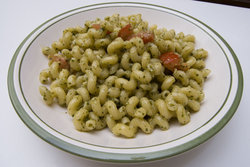
Common pasta sauces in Northern Italy include pesto and ragù alla bolognese; in Central Italy, simple tomato sauce, amatriciana and carbonara, and in Southern Italy, spicy tomato, garlic, and olive oil based sauces, often paired with fresh vegetables or seafood. Varieties include puttanesca, pasta alla norma (tomatoes, eggplant and fresh or baked cheese), pasta con le sarde (fresh sardines, pine nuts, fennel and olive oil), spaghetti aglio, olio e peperoncino (literally with garlic, (olive) oil and hot chili peppers).
Fettuccine alfredo, with butter and cheese, and spaghetti with tomato sauce with or without ground meat or meatballs are popular Italian-style dishes in the United States.
As pasta is introduced elsewhere in the world, it has been incorporated into a number of local cuisines that may have significantly different ways of preparations from those of its country of origin. In Hong Kong, the local Chinese have adopted pasta, primarily spaghetti and macaroni, as an ingredient in the Hong Kong-style Western cuisine. In the territory's Cha chaan tengs, pasta, most commonly macaroni, is cooked in water, and served in broth with ham or frankfurter sausages, peas, black mushrooms, and optionally eggs reminiscent of noodle soup dishes. This is often a course for breakfast or light lunch fare. The method often involves cooking the pasta well beyond the al dente stage and washing the starches off the pasta after cooking, measures frowned upon in Italy or in Hong Kong's more authentic Italian eateries.
See also
External links
- Pasta shapes – history and an abridged list of pasta shapes.
